Ethical Fashion: Analyzing Ethical Practices in the Fashion Industry
VerifiedAdded on 2022/10/09
|17
|3432
|13
Report
AI Summary
This board paper provides a comprehensive analysis of ethical fashion within the industry. It begins with an introduction to ethics and its importance in business, specifically within the fashion sector. The paper then defines ethical fashion, contrasting it with sustainable fashion, and explores the issues surrounding ethical practices, including labor exploitation, working conditions, and environmental impacts. It highlights the concept of "fast fashion" and its detrimental effects, using examples like the Rana Plaza tragedy. The paper examines current consumer trends, including growing interest in ethical brands, and offers recommendations for companies to improve their ethical practices, including strategy implications, fiduciary considerations, and risk analysis. The paper concludes that the fashion industry isn't inherently unethical, but requires careful ethical practices to minimize negative impacts. The paper is structured to inform board members and guide decision-making toward achieving ethical and sustainable goals.
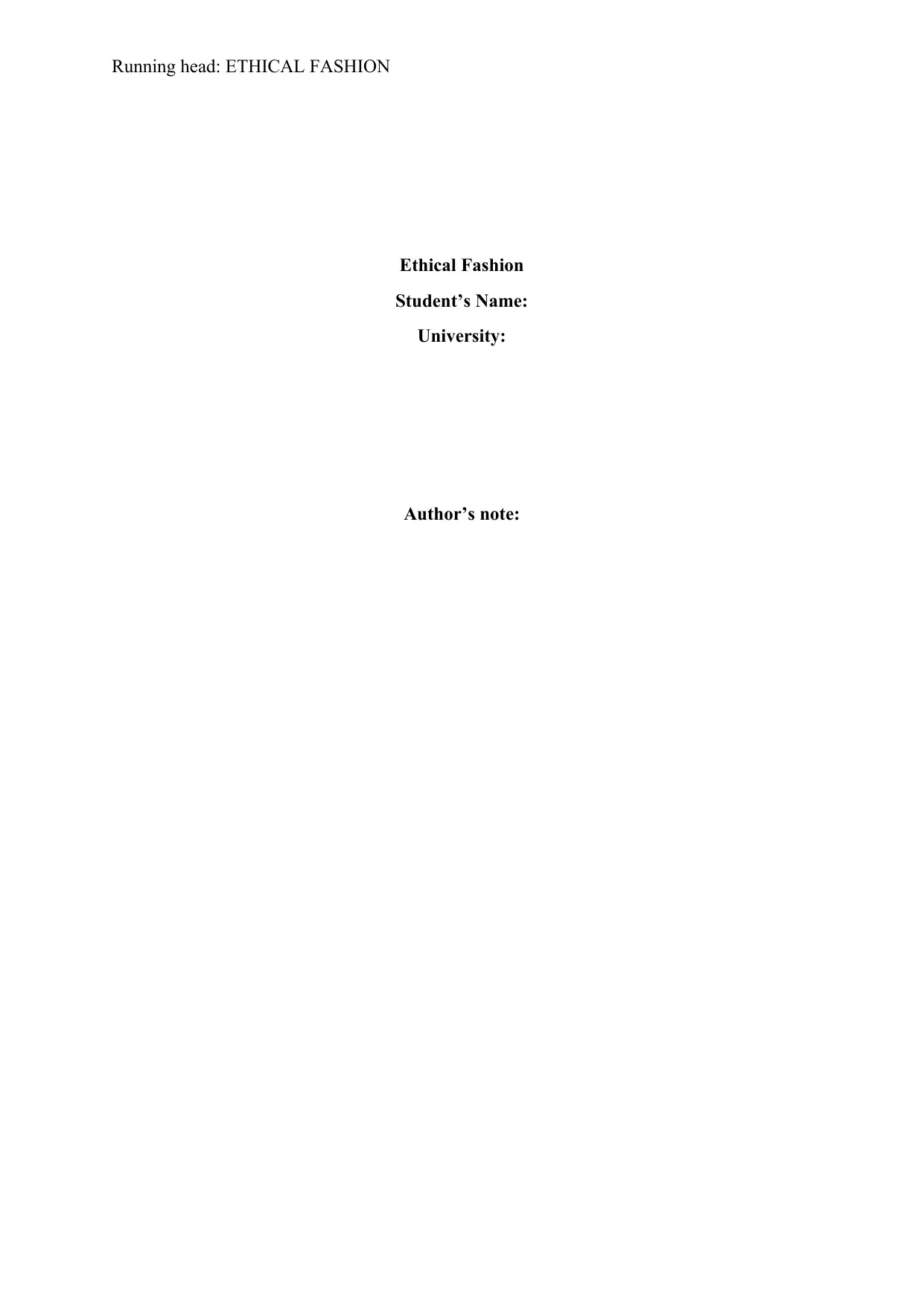
Running head: ETHICAL FASHION
Ethical Fashion
Student’s Name:
University:
Author’s note:
Ethical Fashion
Student’s Name:
University:
Author’s note:
Paraphrase This Document
Need a fresh take? Get an instant paraphrase of this document with our AI Paraphraser
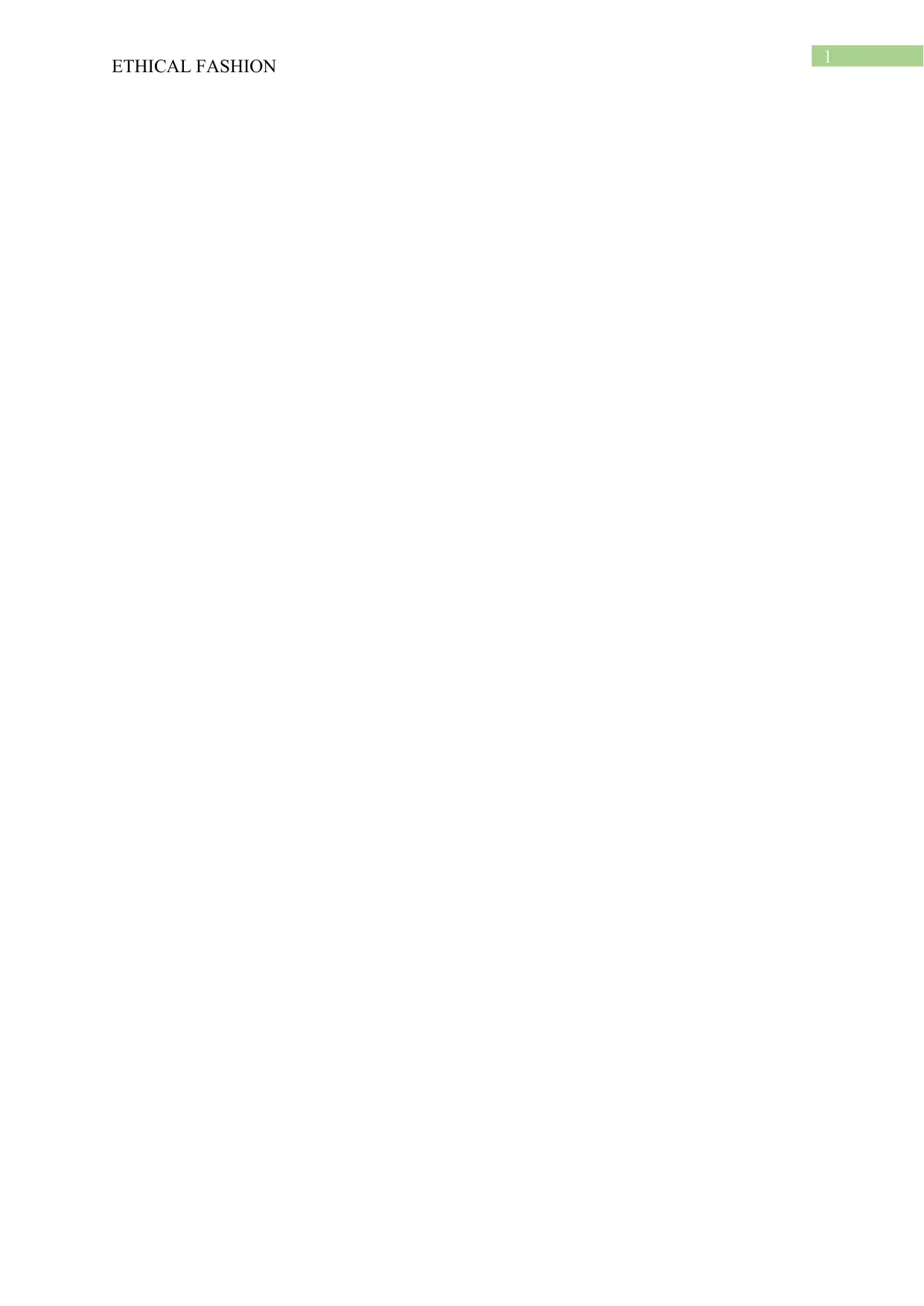
1
ETHICAL FASHION
ETHICAL FASHION
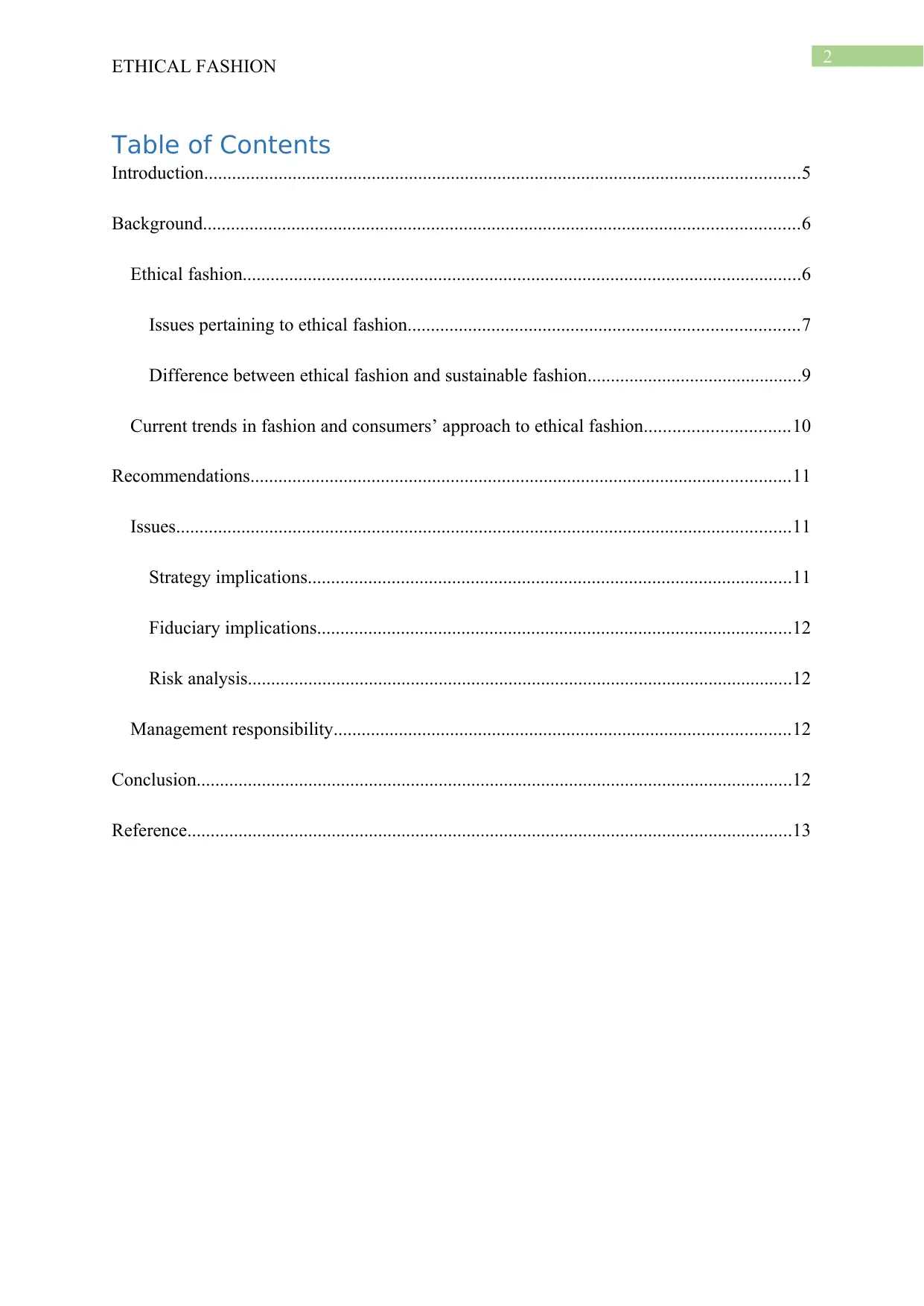
2
ETHICAL FASHION
Table of Contents
Introduction................................................................................................................................5
Background................................................................................................................................6
Ethical fashion........................................................................................................................6
Issues pertaining to ethical fashion....................................................................................7
Difference between ethical fashion and sustainable fashion..............................................9
Current trends in fashion and consumers’ approach to ethical fashion...............................10
Recommendations....................................................................................................................11
Issues....................................................................................................................................11
Strategy implications........................................................................................................11
Fiduciary implications......................................................................................................12
Risk analysis.....................................................................................................................12
Management responsibility..................................................................................................12
Conclusion................................................................................................................................12
Reference..................................................................................................................................13
ETHICAL FASHION
Table of Contents
Introduction................................................................................................................................5
Background................................................................................................................................6
Ethical fashion........................................................................................................................6
Issues pertaining to ethical fashion....................................................................................7
Difference between ethical fashion and sustainable fashion..............................................9
Current trends in fashion and consumers’ approach to ethical fashion...............................10
Recommendations....................................................................................................................11
Issues....................................................................................................................................11
Strategy implications........................................................................................................11
Fiduciary implications......................................................................................................12
Risk analysis.....................................................................................................................12
Management responsibility..................................................................................................12
Conclusion................................................................................................................................12
Reference..................................................................................................................................13
⊘ This is a preview!⊘
Do you want full access?
Subscribe today to unlock all pages.

Trusted by 1+ million students worldwide
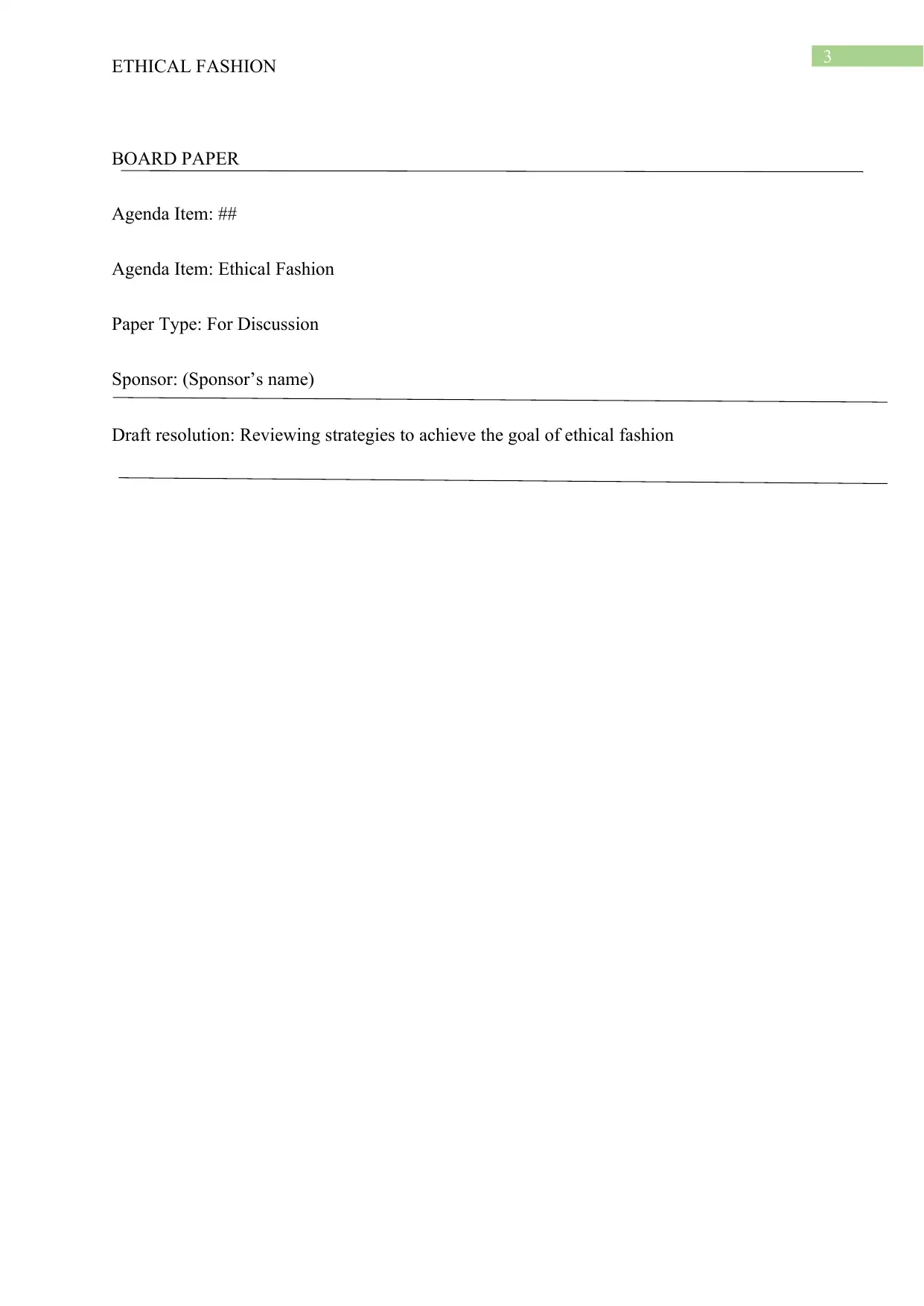
3
ETHICAL FASHION
BOARD PAPER
Agenda Item: ##
Agenda Item: Ethical Fashion
Paper Type: For Discussion
Sponsor: (Sponsor’s name)
Draft resolution: Reviewing strategies to achieve the goal of ethical fashion
ETHICAL FASHION
BOARD PAPER
Agenda Item: ##
Agenda Item: Ethical Fashion
Paper Type: For Discussion
Sponsor: (Sponsor’s name)
Draft resolution: Reviewing strategies to achieve the goal of ethical fashion
Paraphrase This Document
Need a fresh take? Get an instant paraphrase of this document with our AI Paraphraser
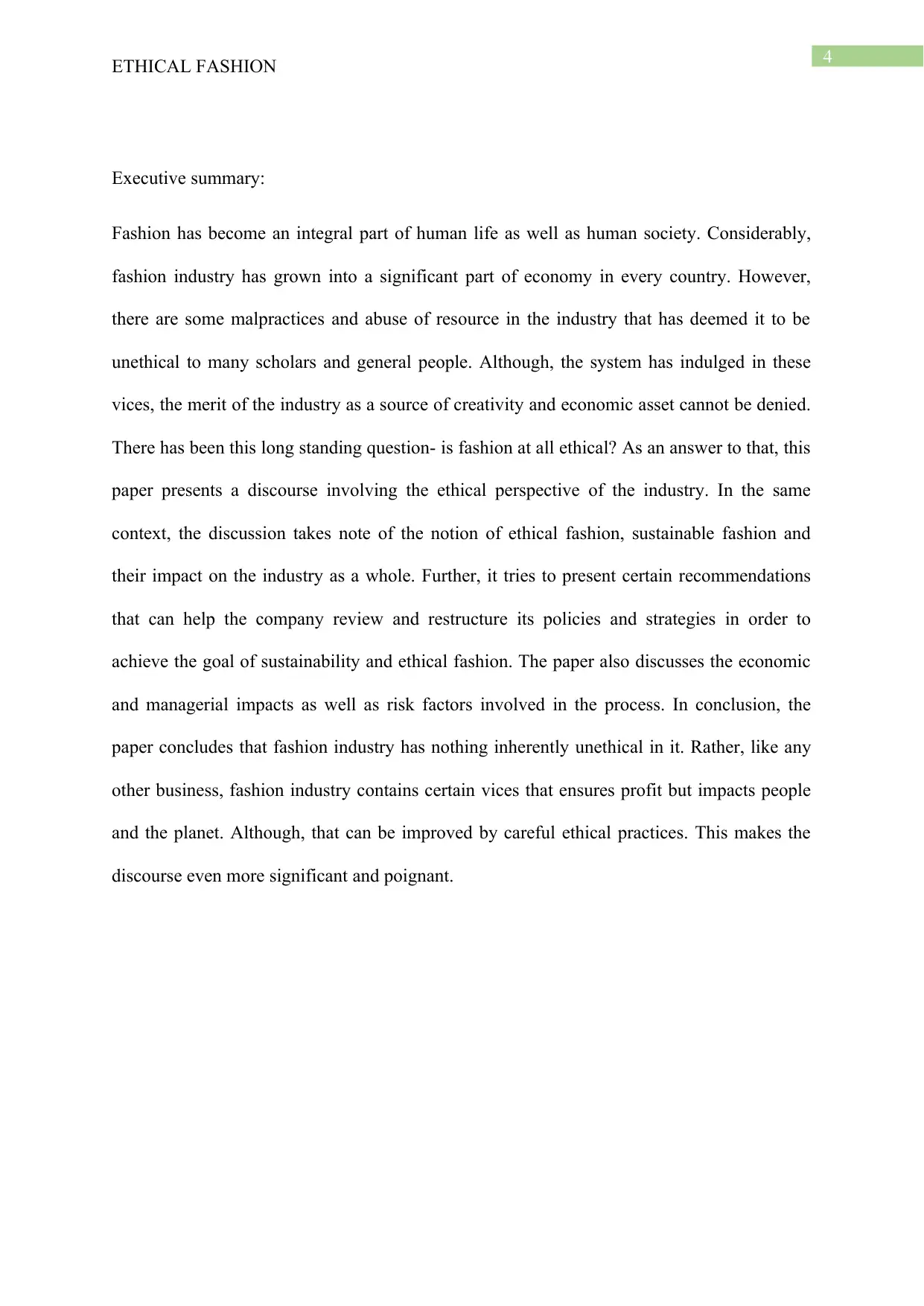
4
ETHICAL FASHION
Executive summary:
Fashion has become an integral part of human life as well as human society. Considerably,
fashion industry has grown into a significant part of economy in every country. However,
there are some malpractices and abuse of resource in the industry that has deemed it to be
unethical to many scholars and general people. Although, the system has indulged in these
vices, the merit of the industry as a source of creativity and economic asset cannot be denied.
There has been this long standing question- is fashion at all ethical? As an answer to that, this
paper presents a discourse involving the ethical perspective of the industry. In the same
context, the discussion takes note of the notion of ethical fashion, sustainable fashion and
their impact on the industry as a whole. Further, it tries to present certain recommendations
that can help the company review and restructure its policies and strategies in order to
achieve the goal of sustainability and ethical fashion. The paper also discusses the economic
and managerial impacts as well as risk factors involved in the process. In conclusion, the
paper concludes that fashion industry has nothing inherently unethical in it. Rather, like any
other business, fashion industry contains certain vices that ensures profit but impacts people
and the planet. Although, that can be improved by careful ethical practices. This makes the
discourse even more significant and poignant.
ETHICAL FASHION
Executive summary:
Fashion has become an integral part of human life as well as human society. Considerably,
fashion industry has grown into a significant part of economy in every country. However,
there are some malpractices and abuse of resource in the industry that has deemed it to be
unethical to many scholars and general people. Although, the system has indulged in these
vices, the merit of the industry as a source of creativity and economic asset cannot be denied.
There has been this long standing question- is fashion at all ethical? As an answer to that, this
paper presents a discourse involving the ethical perspective of the industry. In the same
context, the discussion takes note of the notion of ethical fashion, sustainable fashion and
their impact on the industry as a whole. Further, it tries to present certain recommendations
that can help the company review and restructure its policies and strategies in order to
achieve the goal of sustainability and ethical fashion. The paper also discusses the economic
and managerial impacts as well as risk factors involved in the process. In conclusion, the
paper concludes that fashion industry has nothing inherently unethical in it. Rather, like any
other business, fashion industry contains certain vices that ensures profit but impacts people
and the planet. Although, that can be improved by careful ethical practices. This makes the
discourse even more significant and poignant.
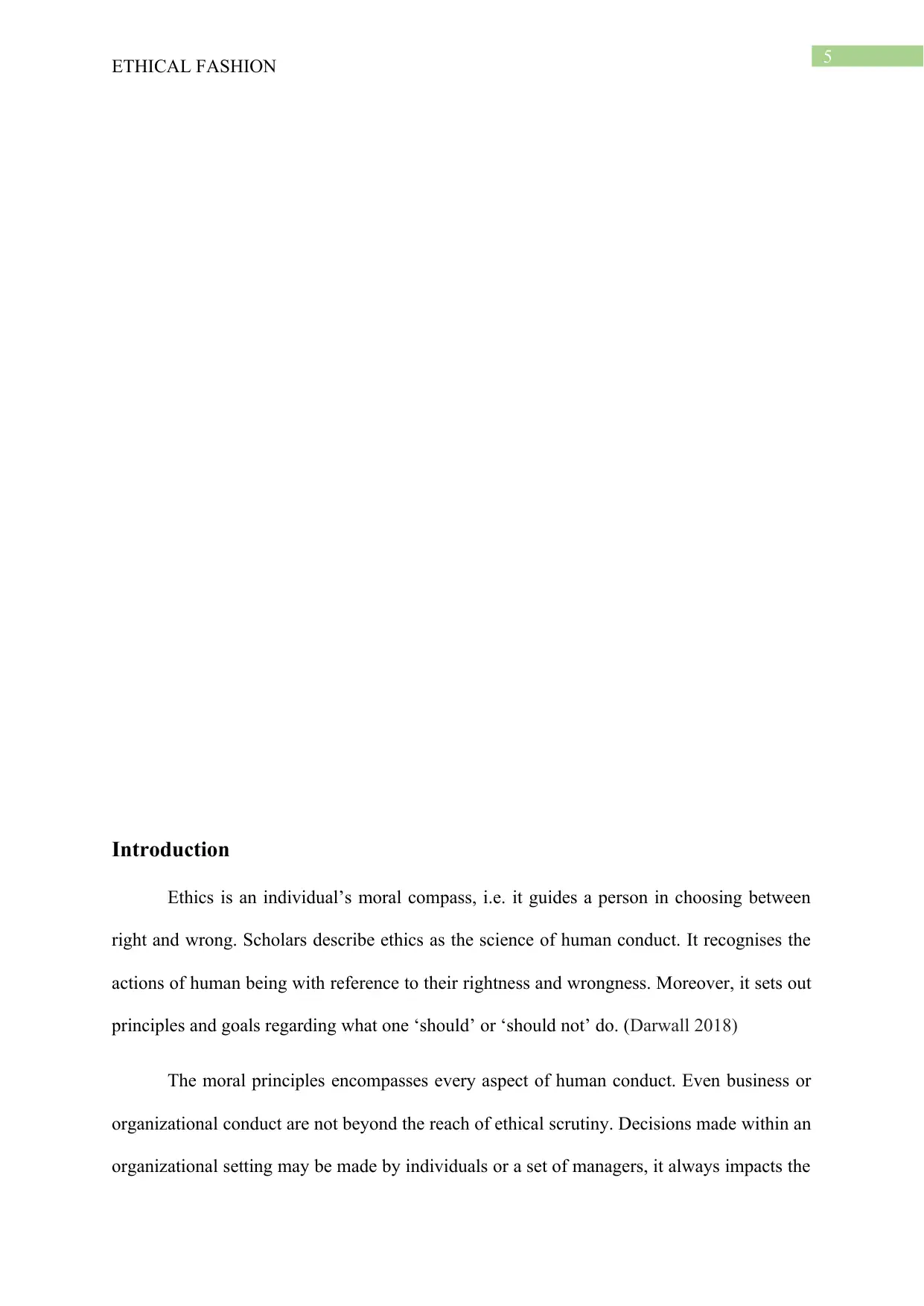
5
ETHICAL FASHION
Introduction
Ethics is an individual’s moral compass, i.e. it guides a person in choosing between
right and wrong. Scholars describe ethics as the science of human conduct. It recognises the
actions of human being with reference to their rightness and wrongness. Moreover, it sets out
principles and goals regarding what one ‘should’ or ‘should not’ do. (Darwall 2018)
The moral principles encompasses every aspect of human conduct. Even business or
organizational conduct are not beyond the reach of ethical scrutiny. Decisions made within an
organizational setting may be made by individuals or a set of managers, it always impacts the
ETHICAL FASHION
Introduction
Ethics is an individual’s moral compass, i.e. it guides a person in choosing between
right and wrong. Scholars describe ethics as the science of human conduct. It recognises the
actions of human being with reference to their rightness and wrongness. Moreover, it sets out
principles and goals regarding what one ‘should’ or ‘should not’ do. (Darwall 2018)
The moral principles encompasses every aspect of human conduct. Even business or
organizational conduct are not beyond the reach of ethical scrutiny. Decisions made within an
organizational setting may be made by individuals or a set of managers, it always impacts the
⊘ This is a preview!⊘
Do you want full access?
Subscribe today to unlock all pages.

Trusted by 1+ million students worldwide
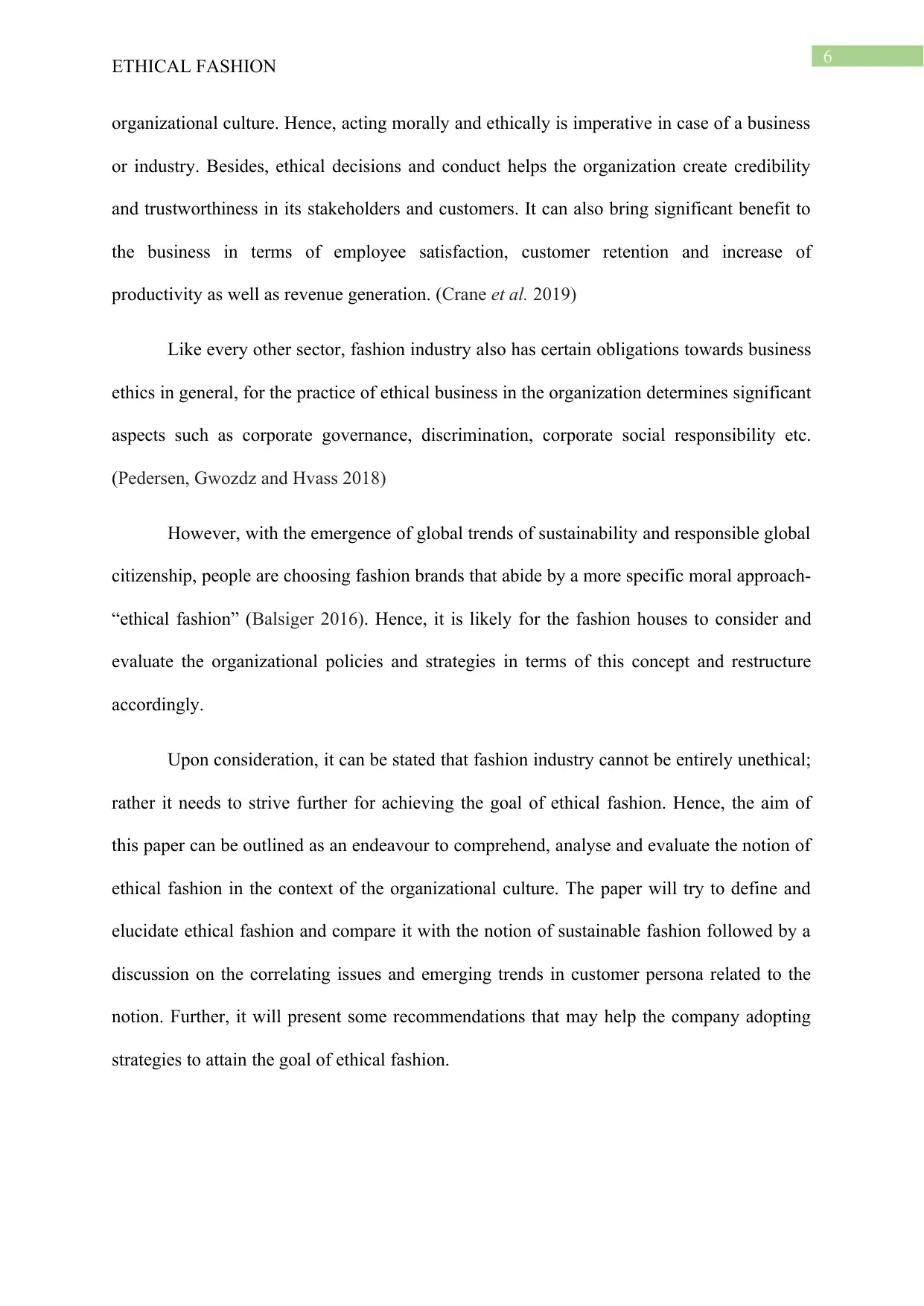
6
ETHICAL FASHION
organizational culture. Hence, acting morally and ethically is imperative in case of a business
or industry. Besides, ethical decisions and conduct helps the organization create credibility
and trustworthiness in its stakeholders and customers. It can also bring significant benefit to
the business in terms of employee satisfaction, customer retention and increase of
productivity as well as revenue generation. (Crane et al. 2019)
Like every other sector, fashion industry also has certain obligations towards business
ethics in general, for the practice of ethical business in the organization determines significant
aspects such as corporate governance, discrimination, corporate social responsibility etc.
(Pedersen, Gwozdz and Hvass 2018)
However, with the emergence of global trends of sustainability and responsible global
citizenship, people are choosing fashion brands that abide by a more specific moral approach-
“ethical fashion” (Balsiger 2016). Hence, it is likely for the fashion houses to consider and
evaluate the organizational policies and strategies in terms of this concept and restructure
accordingly.
Upon consideration, it can be stated that fashion industry cannot be entirely unethical;
rather it needs to strive further for achieving the goal of ethical fashion. Hence, the aim of
this paper can be outlined as an endeavour to comprehend, analyse and evaluate the notion of
ethical fashion in the context of the organizational culture. The paper will try to define and
elucidate ethical fashion and compare it with the notion of sustainable fashion followed by a
discussion on the correlating issues and emerging trends in customer persona related to the
notion. Further, it will present some recommendations that may help the company adopting
strategies to attain the goal of ethical fashion.
ETHICAL FASHION
organizational culture. Hence, acting morally and ethically is imperative in case of a business
or industry. Besides, ethical decisions and conduct helps the organization create credibility
and trustworthiness in its stakeholders and customers. It can also bring significant benefit to
the business in terms of employee satisfaction, customer retention and increase of
productivity as well as revenue generation. (Crane et al. 2019)
Like every other sector, fashion industry also has certain obligations towards business
ethics in general, for the practice of ethical business in the organization determines significant
aspects such as corporate governance, discrimination, corporate social responsibility etc.
(Pedersen, Gwozdz and Hvass 2018)
However, with the emergence of global trends of sustainability and responsible global
citizenship, people are choosing fashion brands that abide by a more specific moral approach-
“ethical fashion” (Balsiger 2016). Hence, it is likely for the fashion houses to consider and
evaluate the organizational policies and strategies in terms of this concept and restructure
accordingly.
Upon consideration, it can be stated that fashion industry cannot be entirely unethical;
rather it needs to strive further for achieving the goal of ethical fashion. Hence, the aim of
this paper can be outlined as an endeavour to comprehend, analyse and evaluate the notion of
ethical fashion in the context of the organizational culture. The paper will try to define and
elucidate ethical fashion and compare it with the notion of sustainable fashion followed by a
discussion on the correlating issues and emerging trends in customer persona related to the
notion. Further, it will present some recommendations that may help the company adopting
strategies to attain the goal of ethical fashion.
Paraphrase This Document
Need a fresh take? Get an instant paraphrase of this document with our AI Paraphraser
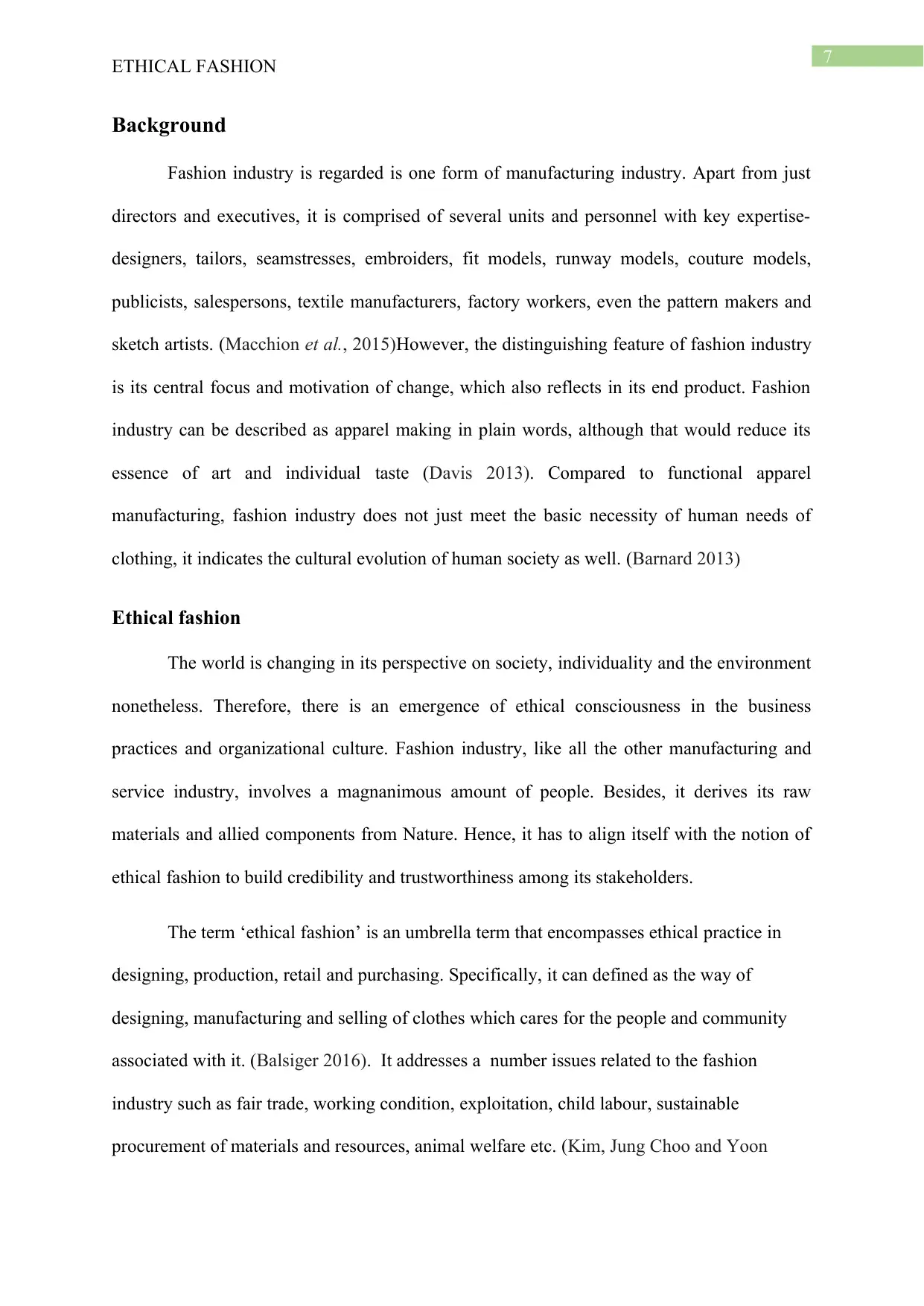
7
ETHICAL FASHION
Background
Fashion industry is regarded is one form of manufacturing industry. Apart from just
directors and executives, it is comprised of several units and personnel with key expertise-
designers, tailors, seamstresses, embroiders, fit models, runway models, couture models,
publicists, salespersons, textile manufacturers, factory workers, even the pattern makers and
sketch artists. (Macchion et al., 2015)However, the distinguishing feature of fashion industry
is its central focus and motivation of change, which also reflects in its end product. Fashion
industry can be described as apparel making in plain words, although that would reduce its
essence of art and individual taste (Davis 2013). Compared to functional apparel
manufacturing, fashion industry does not just meet the basic necessity of human needs of
clothing, it indicates the cultural evolution of human society as well. (Barnard 2013)
Ethical fashion
The world is changing in its perspective on society, individuality and the environment
nonetheless. Therefore, there is an emergence of ethical consciousness in the business
practices and organizational culture. Fashion industry, like all the other manufacturing and
service industry, involves a magnanimous amount of people. Besides, it derives its raw
materials and allied components from Nature. Hence, it has to align itself with the notion of
ethical fashion to build credibility and trustworthiness among its stakeholders.
The term ‘ethical fashion’ is an umbrella term that encompasses ethical practice in
designing, production, retail and purchasing. Specifically, it can defined as the way of
designing, manufacturing and selling of clothes which cares for the people and community
associated with it. (Balsiger 2016). It addresses a number issues related to the fashion
industry such as fair trade, working condition, exploitation, child labour, sustainable
procurement of materials and resources, animal welfare etc. (Kim, Jung Choo and Yoon
ETHICAL FASHION
Background
Fashion industry is regarded is one form of manufacturing industry. Apart from just
directors and executives, it is comprised of several units and personnel with key expertise-
designers, tailors, seamstresses, embroiders, fit models, runway models, couture models,
publicists, salespersons, textile manufacturers, factory workers, even the pattern makers and
sketch artists. (Macchion et al., 2015)However, the distinguishing feature of fashion industry
is its central focus and motivation of change, which also reflects in its end product. Fashion
industry can be described as apparel making in plain words, although that would reduce its
essence of art and individual taste (Davis 2013). Compared to functional apparel
manufacturing, fashion industry does not just meet the basic necessity of human needs of
clothing, it indicates the cultural evolution of human society as well. (Barnard 2013)
Ethical fashion
The world is changing in its perspective on society, individuality and the environment
nonetheless. Therefore, there is an emergence of ethical consciousness in the business
practices and organizational culture. Fashion industry, like all the other manufacturing and
service industry, involves a magnanimous amount of people. Besides, it derives its raw
materials and allied components from Nature. Hence, it has to align itself with the notion of
ethical fashion to build credibility and trustworthiness among its stakeholders.
The term ‘ethical fashion’ is an umbrella term that encompasses ethical practice in
designing, production, retail and purchasing. Specifically, it can defined as the way of
designing, manufacturing and selling of clothes which cares for the people and community
associated with it. (Balsiger 2016). It addresses a number issues related to the fashion
industry such as fair trade, working condition, exploitation, child labour, sustainable
procurement of materials and resources, animal welfare etc. (Kim, Jung Choo and Yoon
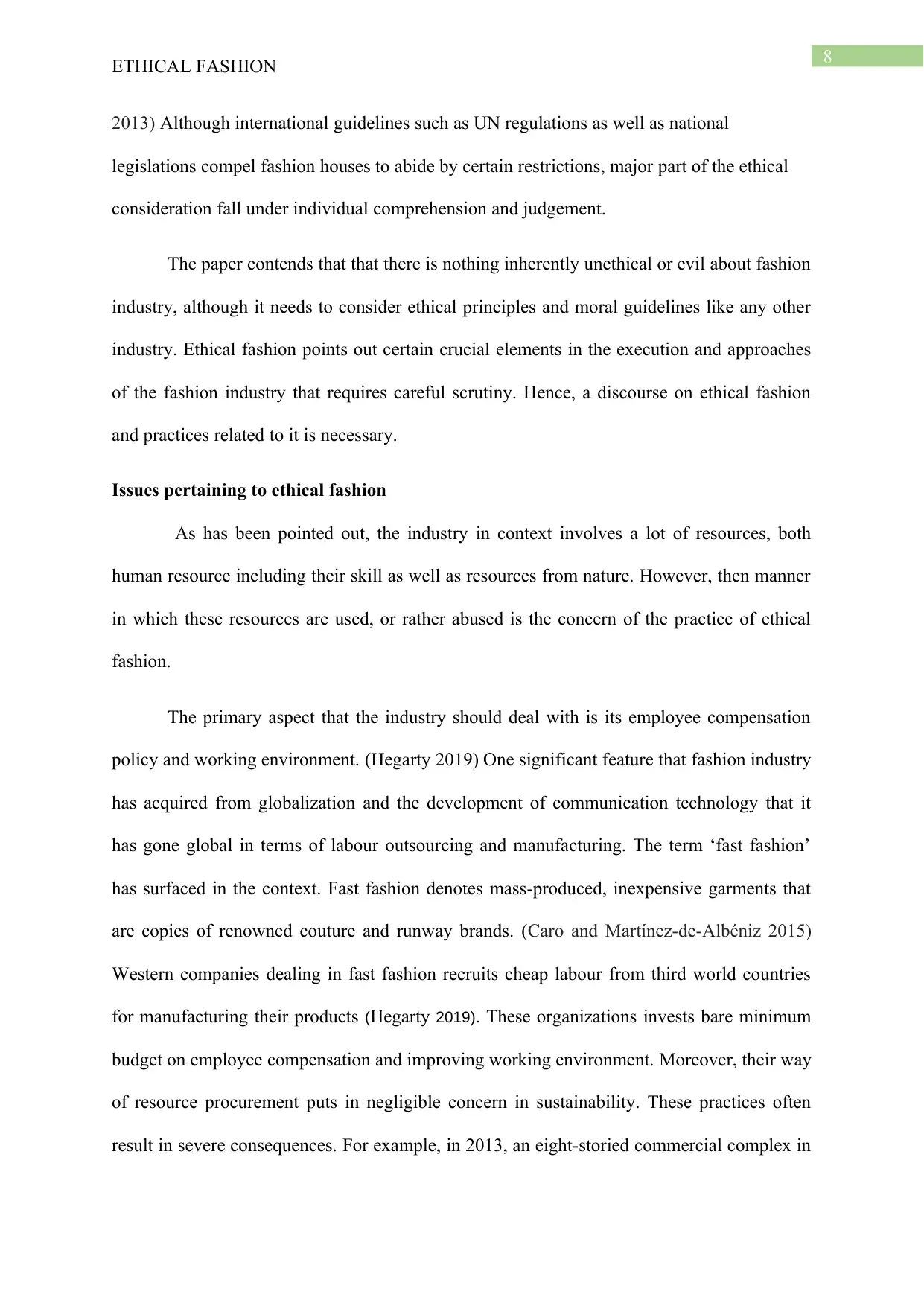
8
ETHICAL FASHION
2013) Although international guidelines such as UN regulations as well as national
legislations compel fashion houses to abide by certain restrictions, major part of the ethical
consideration fall under individual comprehension and judgement.
The paper contends that that there is nothing inherently unethical or evil about fashion
industry, although it needs to consider ethical principles and moral guidelines like any other
industry. Ethical fashion points out certain crucial elements in the execution and approaches
of the fashion industry that requires careful scrutiny. Hence, a discourse on ethical fashion
and practices related to it is necessary.
Issues pertaining to ethical fashion
As has been pointed out, the industry in context involves a lot of resources, both
human resource including their skill as well as resources from nature. However, then manner
in which these resources are used, or rather abused is the concern of the practice of ethical
fashion.
The primary aspect that the industry should deal with is its employee compensation
policy and working environment. (Hegarty 2019) One significant feature that fashion industry
has acquired from globalization and the development of communication technology that it
has gone global in terms of labour outsourcing and manufacturing. The term ‘fast fashion’
has surfaced in the context. Fast fashion denotes mass-produced, inexpensive garments that
are copies of renowned couture and runway brands. (Caro and Martínez-de-Albéniz 2015)
Western companies dealing in fast fashion recruits cheap labour from third world countries
for manufacturing their products (Hegarty 2019). These organizations invests bare minimum
budget on employee compensation and improving working environment. Moreover, their way
of resource procurement puts in negligible concern in sustainability. These practices often
result in severe consequences. For example, in 2013, an eight-storied commercial complex in
ETHICAL FASHION
2013) Although international guidelines such as UN regulations as well as national
legislations compel fashion houses to abide by certain restrictions, major part of the ethical
consideration fall under individual comprehension and judgement.
The paper contends that that there is nothing inherently unethical or evil about fashion
industry, although it needs to consider ethical principles and moral guidelines like any other
industry. Ethical fashion points out certain crucial elements in the execution and approaches
of the fashion industry that requires careful scrutiny. Hence, a discourse on ethical fashion
and practices related to it is necessary.
Issues pertaining to ethical fashion
As has been pointed out, the industry in context involves a lot of resources, both
human resource including their skill as well as resources from nature. However, then manner
in which these resources are used, or rather abused is the concern of the practice of ethical
fashion.
The primary aspect that the industry should deal with is its employee compensation
policy and working environment. (Hegarty 2019) One significant feature that fashion industry
has acquired from globalization and the development of communication technology that it
has gone global in terms of labour outsourcing and manufacturing. The term ‘fast fashion’
has surfaced in the context. Fast fashion denotes mass-produced, inexpensive garments that
are copies of renowned couture and runway brands. (Caro and Martínez-de-Albéniz 2015)
Western companies dealing in fast fashion recruits cheap labour from third world countries
for manufacturing their products (Hegarty 2019). These organizations invests bare minimum
budget on employee compensation and improving working environment. Moreover, their way
of resource procurement puts in negligible concern in sustainability. These practices often
result in severe consequences. For example, in 2013, an eight-storied commercial complex in
⊘ This is a preview!⊘
Do you want full access?
Subscribe today to unlock all pages.

Trusted by 1+ million students worldwide
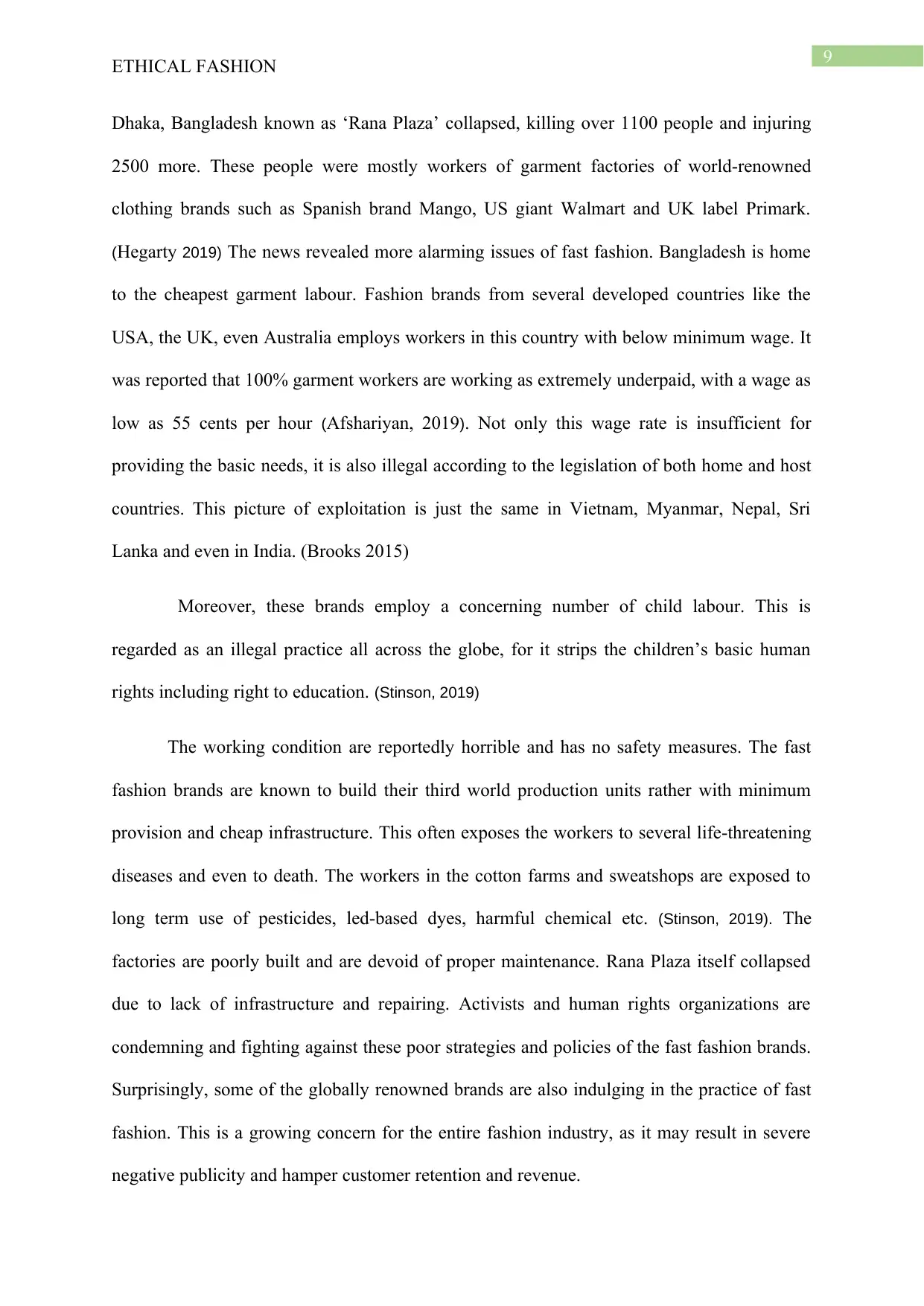
9
ETHICAL FASHION
Dhaka, Bangladesh known as ‘Rana Plaza’ collapsed, killing over 1100 people and injuring
2500 more. These people were mostly workers of garment factories of world-renowned
clothing brands such as Spanish brand Mango, US giant Walmart and UK label Primark.
(Hegarty 2019) The news revealed more alarming issues of fast fashion. Bangladesh is home
to the cheapest garment labour. Fashion brands from several developed countries like the
USA, the UK, even Australia employs workers in this country with below minimum wage. It
was reported that 100% garment workers are working as extremely underpaid, with a wage as
low as 55 cents per hour (Afshariyan, 2019). Not only this wage rate is insufficient for
providing the basic needs, it is also illegal according to the legislation of both home and host
countries. This picture of exploitation is just the same in Vietnam, Myanmar, Nepal, Sri
Lanka and even in India. (Brooks 2015)
Moreover, these brands employ a concerning number of child labour. This is
regarded as an illegal practice all across the globe, for it strips the children’s basic human
rights including right to education. (Stinson, 2019)
The working condition are reportedly horrible and has no safety measures. The fast
fashion brands are known to build their third world production units rather with minimum
provision and cheap infrastructure. This often exposes the workers to several life-threatening
diseases and even to death. The workers in the cotton farms and sweatshops are exposed to
long term use of pesticides, led-based dyes, harmful chemical etc. (Stinson, 2019). The
factories are poorly built and are devoid of proper maintenance. Rana Plaza itself collapsed
due to lack of infrastructure and repairing. Activists and human rights organizations are
condemning and fighting against these poor strategies and policies of the fast fashion brands.
Surprisingly, some of the globally renowned brands are also indulging in the practice of fast
fashion. This is a growing concern for the entire fashion industry, as it may result in severe
negative publicity and hamper customer retention and revenue.
ETHICAL FASHION
Dhaka, Bangladesh known as ‘Rana Plaza’ collapsed, killing over 1100 people and injuring
2500 more. These people were mostly workers of garment factories of world-renowned
clothing brands such as Spanish brand Mango, US giant Walmart and UK label Primark.
(Hegarty 2019) The news revealed more alarming issues of fast fashion. Bangladesh is home
to the cheapest garment labour. Fashion brands from several developed countries like the
USA, the UK, even Australia employs workers in this country with below minimum wage. It
was reported that 100% garment workers are working as extremely underpaid, with a wage as
low as 55 cents per hour (Afshariyan, 2019). Not only this wage rate is insufficient for
providing the basic needs, it is also illegal according to the legislation of both home and host
countries. This picture of exploitation is just the same in Vietnam, Myanmar, Nepal, Sri
Lanka and even in India. (Brooks 2015)
Moreover, these brands employ a concerning number of child labour. This is
regarded as an illegal practice all across the globe, for it strips the children’s basic human
rights including right to education. (Stinson, 2019)
The working condition are reportedly horrible and has no safety measures. The fast
fashion brands are known to build their third world production units rather with minimum
provision and cheap infrastructure. This often exposes the workers to several life-threatening
diseases and even to death. The workers in the cotton farms and sweatshops are exposed to
long term use of pesticides, led-based dyes, harmful chemical etc. (Stinson, 2019). The
factories are poorly built and are devoid of proper maintenance. Rana Plaza itself collapsed
due to lack of infrastructure and repairing. Activists and human rights organizations are
condemning and fighting against these poor strategies and policies of the fast fashion brands.
Surprisingly, some of the globally renowned brands are also indulging in the practice of fast
fashion. This is a growing concern for the entire fashion industry, as it may result in severe
negative publicity and hamper customer retention and revenue.
Paraphrase This Document
Need a fresh take? Get an instant paraphrase of this document with our AI Paraphraser
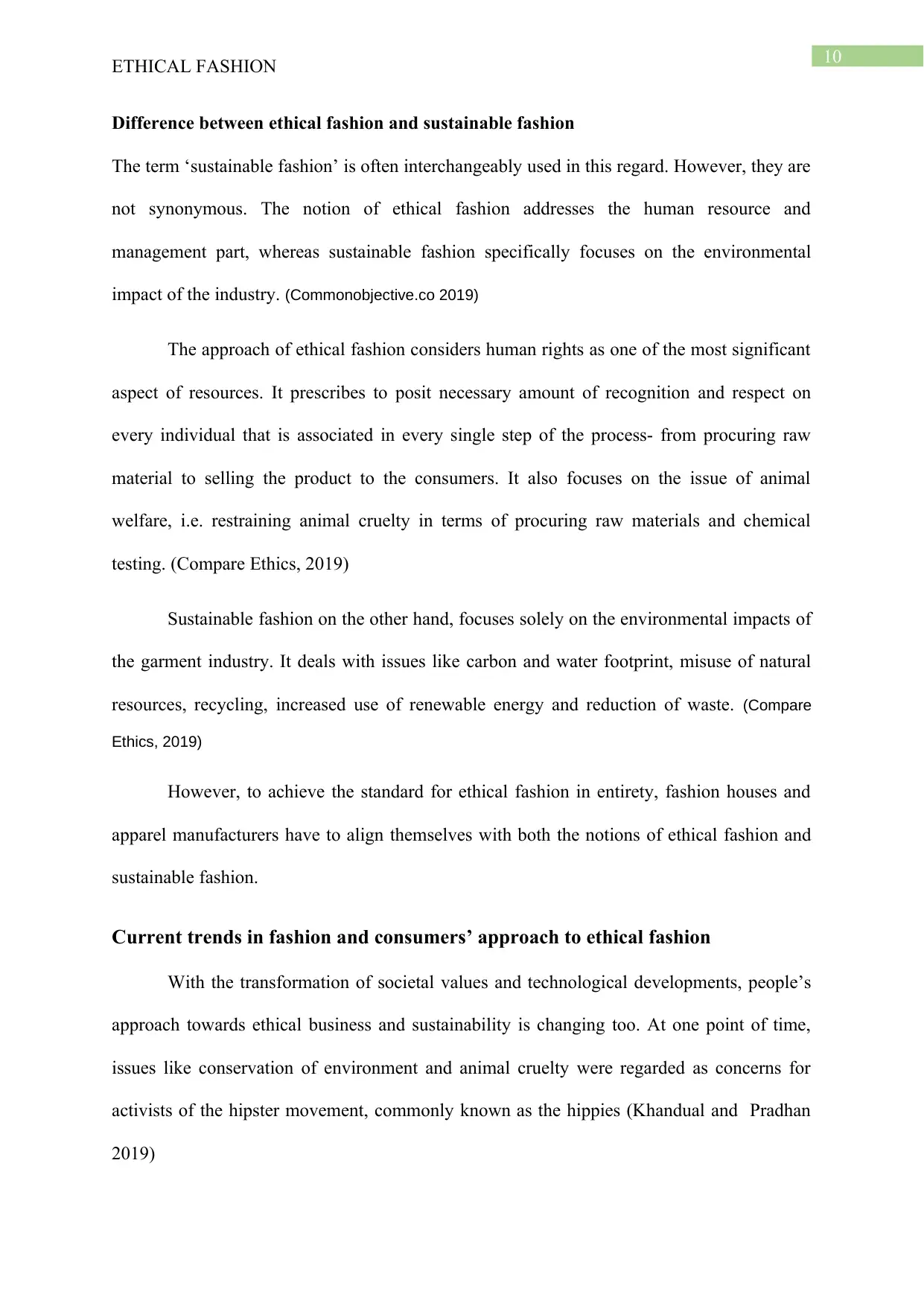
10
ETHICAL FASHION
Difference between ethical fashion and sustainable fashion
The term ‘sustainable fashion’ is often interchangeably used in this regard. However, they are
not synonymous. The notion of ethical fashion addresses the human resource and
management part, whereas sustainable fashion specifically focuses on the environmental
impact of the industry. (Commonobjective.co 2019)
The approach of ethical fashion considers human rights as one of the most significant
aspect of resources. It prescribes to posit necessary amount of recognition and respect on
every individual that is associated in every single step of the process- from procuring raw
material to selling the product to the consumers. It also focuses on the issue of animal
welfare, i.e. restraining animal cruelty in terms of procuring raw materials and chemical
testing. (Compare Ethics, 2019)
Sustainable fashion on the other hand, focuses solely on the environmental impacts of
the garment industry. It deals with issues like carbon and water footprint, misuse of natural
resources, recycling, increased use of renewable energy and reduction of waste. (Compare
Ethics, 2019)
However, to achieve the standard for ethical fashion in entirety, fashion houses and
apparel manufacturers have to align themselves with both the notions of ethical fashion and
sustainable fashion.
Current trends in fashion and consumers’ approach to ethical fashion
With the transformation of societal values and technological developments, people’s
approach towards ethical business and sustainability is changing too. At one point of time,
issues like conservation of environment and animal cruelty were regarded as concerns for
activists of the hipster movement, commonly known as the hippies (Khandual and Pradhan
2019)
ETHICAL FASHION
Difference between ethical fashion and sustainable fashion
The term ‘sustainable fashion’ is often interchangeably used in this regard. However, they are
not synonymous. The notion of ethical fashion addresses the human resource and
management part, whereas sustainable fashion specifically focuses on the environmental
impact of the industry. (Commonobjective.co 2019)
The approach of ethical fashion considers human rights as one of the most significant
aspect of resources. It prescribes to posit necessary amount of recognition and respect on
every individual that is associated in every single step of the process- from procuring raw
material to selling the product to the consumers. It also focuses on the issue of animal
welfare, i.e. restraining animal cruelty in terms of procuring raw materials and chemical
testing. (Compare Ethics, 2019)
Sustainable fashion on the other hand, focuses solely on the environmental impacts of
the garment industry. It deals with issues like carbon and water footprint, misuse of natural
resources, recycling, increased use of renewable energy and reduction of waste. (Compare
Ethics, 2019)
However, to achieve the standard for ethical fashion in entirety, fashion houses and
apparel manufacturers have to align themselves with both the notions of ethical fashion and
sustainable fashion.
Current trends in fashion and consumers’ approach to ethical fashion
With the transformation of societal values and technological developments, people’s
approach towards ethical business and sustainability is changing too. At one point of time,
issues like conservation of environment and animal cruelty were regarded as concerns for
activists of the hipster movement, commonly known as the hippies (Khandual and Pradhan
2019)
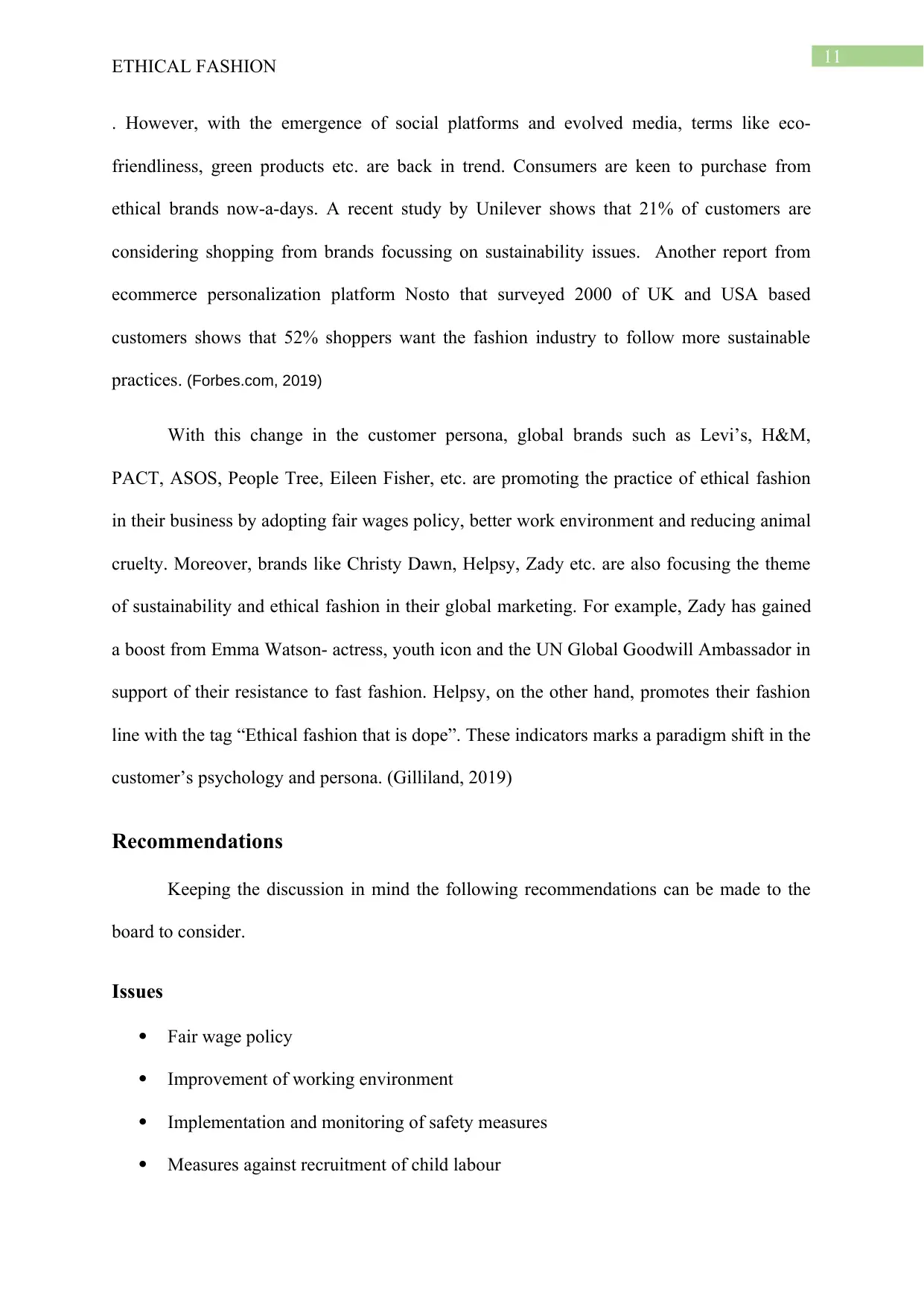
11
ETHICAL FASHION
. However, with the emergence of social platforms and evolved media, terms like eco-
friendliness, green products etc. are back in trend. Consumers are keen to purchase from
ethical brands now-a-days. A recent study by Unilever shows that 21% of customers are
considering shopping from brands focussing on sustainability issues. Another report from
ecommerce personalization platform Nosto that surveyed 2000 of UK and USA based
customers shows that 52% shoppers want the fashion industry to follow more sustainable
practices. (Forbes.com, 2019)
With this change in the customer persona, global brands such as Levi’s, H&M,
PACT, ASOS, People Tree, Eileen Fisher, etc. are promoting the practice of ethical fashion
in their business by adopting fair wages policy, better work environment and reducing animal
cruelty. Moreover, brands like Christy Dawn, Helpsy, Zady etc. are also focusing the theme
of sustainability and ethical fashion in their global marketing. For example, Zady has gained
a boost from Emma Watson- actress, youth icon and the UN Global Goodwill Ambassador in
support of their resistance to fast fashion. Helpsy, on the other hand, promotes their fashion
line with the tag “Ethical fashion that is dope”. These indicators marks a paradigm shift in the
customer’s psychology and persona. (Gilliland, 2019)
Recommendations
Keeping the discussion in mind the following recommendations can be made to the
board to consider.
Issues
Fair wage policy
Improvement of working environment
Implementation and monitoring of safety measures
Measures against recruitment of child labour
ETHICAL FASHION
. However, with the emergence of social platforms and evolved media, terms like eco-
friendliness, green products etc. are back in trend. Consumers are keen to purchase from
ethical brands now-a-days. A recent study by Unilever shows that 21% of customers are
considering shopping from brands focussing on sustainability issues. Another report from
ecommerce personalization platform Nosto that surveyed 2000 of UK and USA based
customers shows that 52% shoppers want the fashion industry to follow more sustainable
practices. (Forbes.com, 2019)
With this change in the customer persona, global brands such as Levi’s, H&M,
PACT, ASOS, People Tree, Eileen Fisher, etc. are promoting the practice of ethical fashion
in their business by adopting fair wages policy, better work environment and reducing animal
cruelty. Moreover, brands like Christy Dawn, Helpsy, Zady etc. are also focusing the theme
of sustainability and ethical fashion in their global marketing. For example, Zady has gained
a boost from Emma Watson- actress, youth icon and the UN Global Goodwill Ambassador in
support of their resistance to fast fashion. Helpsy, on the other hand, promotes their fashion
line with the tag “Ethical fashion that is dope”. These indicators marks a paradigm shift in the
customer’s psychology and persona. (Gilliland, 2019)
Recommendations
Keeping the discussion in mind the following recommendations can be made to the
board to consider.
Issues
Fair wage policy
Improvement of working environment
Implementation and monitoring of safety measures
Measures against recruitment of child labour
⊘ This is a preview!⊘
Do you want full access?
Subscribe today to unlock all pages.

Trusted by 1+ million students worldwide
1 out of 17
Related Documents
Your All-in-One AI-Powered Toolkit for Academic Success.
+13062052269
info@desklib.com
Available 24*7 on WhatsApp / Email
![[object Object]](/_next/static/media/star-bottom.7253800d.svg)
Unlock your academic potential
Copyright © 2020–2025 A2Z Services. All Rights Reserved. Developed and managed by ZUCOL.



